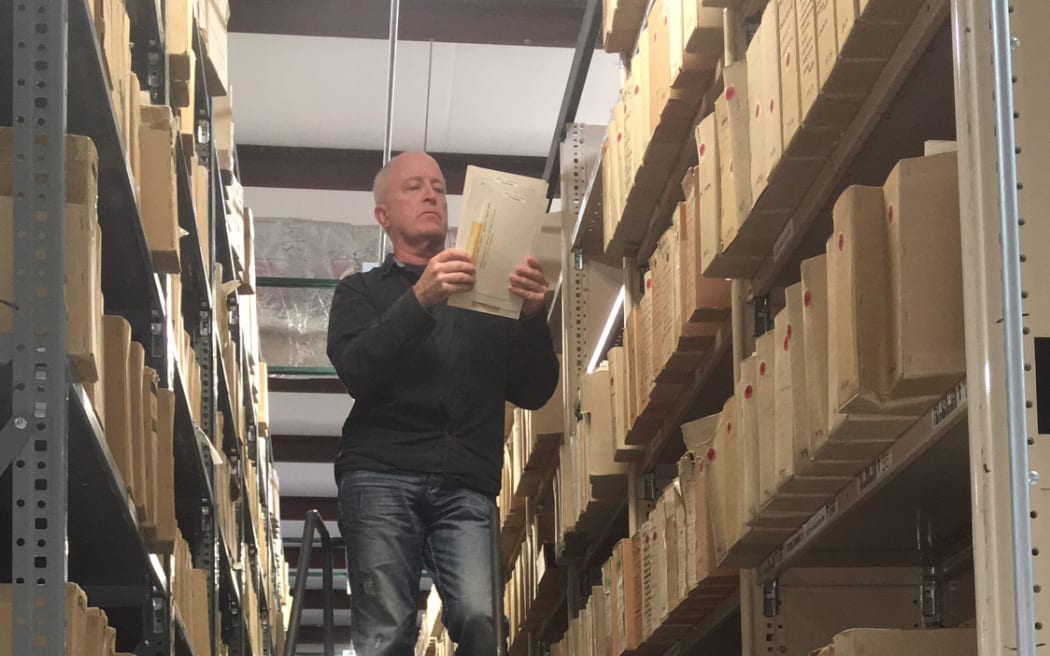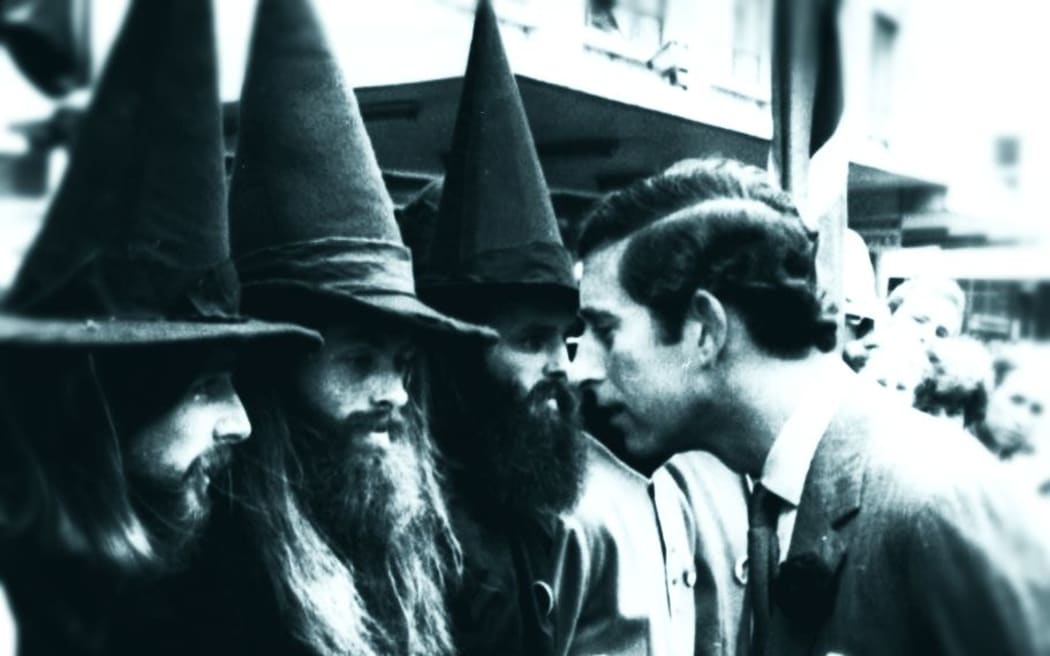A decade ago our biggest newspaper publisher made an ill-fated deal to send almost all of its entire archive of photos offshore to be digitised. They never came back - and now their LA-based owner has put them on the market online, hoping a buyer will put them in public hands.

Daniel Miller in the gallery archive Photo: Duncan Miller Gallery
Back in 2103, our biggest publisher of news, Fairfax Media - these days under new management as Stuff - did a deal which seemed like a good idea at the time.
But it ended up meaning decades-worth of irreplaceable images of historical significance were sent offshore never to return again.
It was thought the Protected Objects Act gave the Ministry for Culture and Heritage the power to block the export of photos over 50 years old, but it turned out Fairfax did not know that when it did the deal.
The ministry eventually gave permission anyway to send almost the entire photographic archive to an operator in the US who promised - in exchange for the originals - to digitise the lot: millions of photos and negatives gathered over more than one hundred years for The Press, The Evening Post, Timaru Herald, Manawatu Standard - and plenty more papers.
Other publishers and papers - including Fairfax’s Sydney Morning Herald - had also taken up similar offers from the Rogers Photo Archive company in Little Rock, Arkansas - whose website bore the mission statement: ‘Preserve, Protect and Profit.’
Fairfax Media’s executive editor at the time, Paul Thompson who is now RNZ’s chief executive, - told the Herald in 2013 it was the only way to save the archives from years of neglect and decay.
“It's no good having millions of photographs that are impossible to access, poorly stored and scattered to the four winds," he said.
A searchable digital database was an attractive idea, but two years later the digitising was nowhere near done - and some images from the collection were showing up for sale on EBay.
The FBI raided John Rogers’ home in 2014 after sports memorabilia he sold turned out to be copies. After that the Rogers Photo Archive went into receivership facing lawsuits of more than $US100 million.
George Waldon, senior editor at Arkansas Business Weekly told Mediawatch in 2015 the digitisation was reportedly about half-done and the court-appointed receiver was trying to do a deal with Fairfax Media and the New Zealand government to return the images.
Stuff chief executive Sinead Boucher told Mediawatch the digitisation of the photos sent offshore was eventually completed. Fairfax Media received a complete digital database of images that is in use today by Stuff.
Some of the original photos in the collection were sold here through auction house Webb’s from mid-2021 onwards. One sale offered more than 700 images of the royal family in New Zealand.
It turned out the owner was Los Angeles-based art dealer Daniel Miller, who had negotiated the purchase of the Fairfax archive with the receiver in Arkansas in 2017.
The US-based Artnet News reported at the time Daniel Miller hired librarians to sort the images and even went to Australia to do deals with libraries and museums. The archive’s selection of 25,000 cricket photographs found a new home at the Donald Bradman Museum in Bowral, New South Wales.
Then this week, in a statement from a local PR agent here, Daniel Miller said he has launched its own local auction platform - TheFairfaxArchives.co.nz - where selected images can be purchased from 14 November.
“I never set out to do this. I was contacted by the court receiver when Rogers (Photo Archive) went upside down and the local bank took possession,” Daniel Miller told Mediawatch.
“They had no idea what to do with photographs. (They were) going to sit and get mouldy somewhere get sent to the landfill. We negotiated for a long period of time and we ended up buying the work,” he said.
“My ongoing intent is to have every one of them back in New Zealand. There's no reason for them to be any place else,” he said.
“I hired two different archivists to go through and organize the material for three and a half years, one photo at a time basically to give us a handle, a sense of what we even add, because frankly, I didn't even know what that was,” he said.

“I'm very proud to say that the (Australian Fairfax) archive now is in 70 different institutions around Australia, and the National Library has come back to buy its third section of work from us. So it's worked really well. We’re trying to do the same in New Zealand ... but there's no playbook for this,” he said. Photo: Prince Charles - as he was - meets wizards on a royal tour in a photo in the Fairfax Media photo archive.
But if he’s now set up a website where individual New Zealand images can be bought and sold, does that mean it hasn't worked?
“We're still in the early stages. For the last two years, we've done many single piece auctions using an auction house in Auckland. But that’s a tiny fraction of the archive that's gone through the auction block,” Daniel Miller told Mediawatch.
But Miller isn’t a librarian or or a charity. He is a dealer who will want a return on this.
“Obviously I want to get the money back that we've invested. My assumption was ... we would own it for a couple of months, we could save it and we'd be the ‘bridge’ - but we have ended up an island,” he said.
“At the end of the day, yes, we need to get our money back. The costs have been extraordinarily high. We're not in the black yet after a little over three years,” he said.
Is he disappointed that our National Library or the government has not yet moved to acquire them? Or even Fairfax’s successor Stuff?
“I contacted a couple of the institutions, but there are too many photos, and they didn't want everything,” he said.
“Back in the day Fairfax was a wounded animal. They were just trying to stay alive. I think they were happy when (the photos) went away - and they had a salesman that came in from Arkansas and sell them a wild bill of goods. But - as most people have heard in life - if it sounds too good to be true, you better take two looks at it,” Miller told Mediawatch.
“I think it was a terrible idea. I think the management of Fairfax should be held accountable. We have our share of haters and people thinking we’re dividing it all up, but that's really easy to say,” he said.
“I also discovered some that were stored in New Zealand in an outside storage locker at a Kennard storage facility. Ten or maybe 15 percent of the ones that were stored there were ruined from black mould. People that were handling this, I think on the government side, had no idea what they were doing,” he told Mediawatch.
“I hired two researchers actually in New Zealand and an American to look into the Protected Objects Act and this archive doesn't fall into that category. There was nothing in the law that would have prevented or required the permission for the sale, they could have gone ahead and done it without the government being involved at all,” Miller told Mediawatch.
"So one of the reasons is, first of all, it only protects works over 50 years old. Okay. And that's maybe 10 percent of this archive, maybe 15 percent of this archive. Okay. So right away. Now, it only protects works that [were] have some New Zealand consequence. This archive is about 30 percent. Commonwealth, meaning primarily British, so there's a ton of British and other foreign material in here.
"The Act also says that if similar objects are included in two or more public institutions in New Zealand, the Act does not apply. We discovered there about 10 million photographs similar (to ones in) this archive split across about 50 different institutions. Apparently, the government either didn't know or didn't care or didn't take the time to look,” he told Mediawatch.
“If somebody has the money to buy this whole thing from us right now, today, I'd be happy to hand it over to a patriotic, high net-worth New Zealander. But it's a lot to handle,” he said.
“I consider that what we're doing is a very good thing, responsibly repatriating them ... because the libraries, the institutions and even the private collectors that they go to are going to have a lifetime of value from these pieces,” he said.
“I'm a fan of protected objects. I'm a fan of cultural heritage. And regardless, we're returning this material to New Zealand anyway.
“I can tell you at this moment, these photos are the best storage they've been in their entire life. I'm looking at a looking at two metres right now I can see the humidity of the warehouse on my phone. So we're 42 percent humidity now which makes me very happy,” he said.


